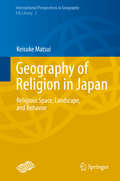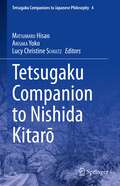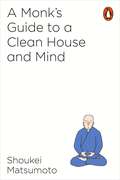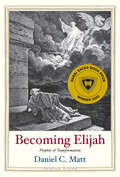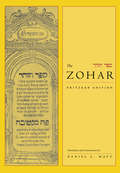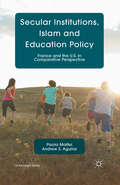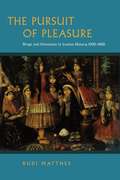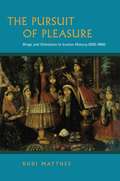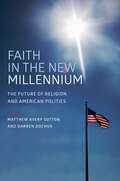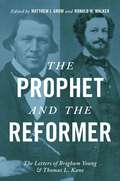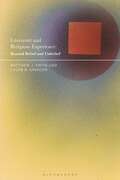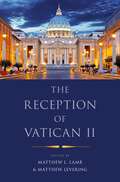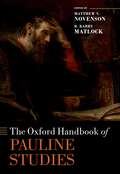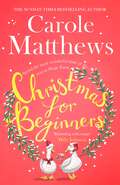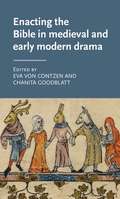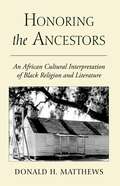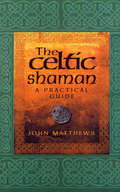- Table View
- List View
Household Conversion Narratives in Acts: Pattern and Interpretation (The Library of New Testament Studies #123)
by David MatsonUsing features of the narrative-critical method, this book offers an innovative approach to a notable phenomenon in the book of Acts: the conversion of entire households to the Christian faith. When viewed against the household mission of the seventy(-two) messengers in Luke, the stories of Cornelius, Lydia, the Roman jailer and Crispus comprise a pattern of evangelistic activity that provides a common framework for their interpretation. Repetition and variation of the pattern offer important clues for the way each story functions within the wider context of Acts, opening up new lines of interpretation as well as new levels of unity/disunity between the Lukan writings.
Geography of Religion in Japan: Religious Space, Landscape, and Behavior (International Perspectives in Geography #2)
by Keisuke MatsuiThis book discusses modern aspects of Japanese religion in terms of cultural geography. To understand the function of religion, it is essential to examine it in the context of local societies. One of the distinguishing characteristics of Japanese religion is its diversity; indeed, it is often remarked that “Japan is a museum of religions.” In this work, the author clarifies some geographical aspects of the complex situation of Japanese religion. Chapter 1 discusses the trend of geographical studies of religion in Japan, of which four types can be identified. Chapter 2 focuses on certain characteristics of Japanese religious traditions by discussing tree worship and the landscape of sacred places. Chapter 3 clarifies regional divisions in the catchment areas of Japanese Shintoism by analyzing the distribution of certain types of believers. The author discusses two case studies: the Kasama Inari Shrine and the Kanamura Shrine. Chapter 4 discusses some modern aspects of sacred places and tourism through two case studies. The first part of the chapter focuses on changes in the types of businesses at the Omotesando of the Naritasan Shinshoji-Monzenmachi, and the following sections examine the revitalization of the local community through the promotion of religious tourism.
Tetsugaku Companion to Nishida Kitarō (Tetsugaku Companions to Japanese Philosophy #4)
by Hisao Matsumaru Yoko Arisaka Lucy Christine SchultzThis book offers the first comprehensive collection of essays on the key concepts of Kitaro Nishida (1870-1945), the father of modern Japanese philosophy and founder of the Kyoto School. The essays analyze several of the major philosophical concepts in Nishida, including pure experience, absolute will, place, and acting intuition. They examine the meaning and positioning of Nishida’s philosophy in the history of philosophy, as well as in the contemporary world, and discuss the relevance of his philosophy in the present context. The book next looks at the significance of Nishida’s philosophy in the wider contexts of science, arts, and religion. The book includes a glossary of key terms that have been translated in a unified manner throughout the volume.
A Monk's Guide to a Clean House and Mind: Housekeeping Secrets From The World's Tidiest Monks
by Shoukei MatsumotoCleanliness is next to enlightenment. In this Japanese bestseller a Buddhist monk explains the traditional cleaning techniques that will help cleanse not only your house - but your soul.'We remove dust to sweep away our worldly desires. We scrub dirt to free ourselves of attachments. We live simply and take time to contemplate the self, mindfully living each moment. It's not just monks that need to live this way. Everyone in today's busy world today needs it.The Zen sect of Buddhism is renowned for the cleanliness of its monks, but cleaning is greatly valued in Japanese Buddhism in general as a way to cultivate the mind. In this book, I introduce everyday cleaning methods typically employed in temples, while sharing what it's like to be a monk in training.This book will improve the condition not just of your own mind, but also the people around you. I hope readers will discover that cleanliness is an opportunity to contemplate oneself.'
Becoming Elijah: Prophet of Transformation (Jewish Lives)
by Daniel C. MattThe story of the prophet Elijah’s transformation from fierce zealot to compassionate hero and cherished figure in Jewish folklore
The Zohar: Pritzker Edition, Volume Four (PDF) (The Zohar: Pritzker Edition)
by Daniel C MattSefer ha-Zohar (The Book of Radiance) has amazed and overwhelmed readers ever since it emerged mysteriously in medieval Spain toward the end of the thirteenth century. Written in a unique, lyrical Aramaic, this masterpiece of Kabbalah exceeds the dimensions of a normal book; it is virtually a body of literature, comprising over twenty discrete sections. The bulk of the Zohar consists of a running commentary on the Torah, from Genesis through Deuteronomy. This fourth volume of The Zohar: Pritzker Edition covers the first half of Exodus. Here we find mystical explorations of Pharaoh's enslavement of the Israelites, the birth of Moses, the deliverance from Egypt, the crossing of the Red Sea, and the Revelation at Mount Sinai. Throughout, the Zohar probes the biblical text and seeks deeper meaning—for example, the nature of evil and its relation to the divine realm, the romance of Moses and Shekhinah, and the inner meaning of the Ten Commandments. In the context of the miraculous splitting of the Red Sea, Rabbi Shim'on reveals the mysterious Name of 72, a complex divine name consisting of 216 letters (72 triads), formed out of three verses in Exodus 14. These mystical interpretations are interwoven with tales of the Companions—rabbis wandering through the hills of Galilee, sharing their insights, coming upon wisdom in the most astonishing ways from a colorful cast of characters they meet on the road.
Secular Institutions, Islam and Education Policy: France and the U.S. in Comparative Perspective (St Antony's Series)
by P. Mattei A. AguilarAmidst claims of threats to national identities in an era of increasing diversity, should we be worried about the upsurge in religious animosity in the United States, as well as Europe? This book explores how French society is divided along conflicts about religion, increasingly visible in public schools, and shows the effect that this has had.
Der Osten: Neue sozialwissenschaftliche Perspektiven auf einen komplexen Gegenstand jenseits von Verurteilung und Verklärung
by Sandra Matthäus Daniel KubiakDas Buch versammelt Beiträge, die neue Perspektiven auf „den Osten“ eröffnen. Sie hinterfragen jenseits einer den Diskurs lähmenden „Einheitsfiktion“ unterkomplexe Ost-West- und Wiedervereinigungsnarrative sowie Nachwendemythen und decken blinde Flecken in der bisherigen Ostdeutschlandforschung auf. Forschungslogisch sind sie verstärkt theoriegeleitet und qualitativ ausgerichtet. Auf diese Art lösen sie die privaten und politischen sowie die wissenschaftlichen Diskurse aus ihrer Trägheit und Eindimensionalität und tragen zu einem besseren Verständnis des Werden und Seins innerdeutscher (Ungleichheits-) Verhältnisse bei.
The Pursuit of Pleasure: Drugs and Stimulants in Iranian History, 1500-1900
by Rudi MattheeFrom ancient times to the present day, Iranian social, political, and economic life has been dramatically influenced by psychoactive agents. This book looks at the stimulants that, as put by a longtime resident of seventeenth-century Iran, Raphaël du Mans, provided Iranians with damagh, gave them a "kick," got them into a good mood. By tracing their historical trajectory and the role they played in early modern Iranian society (1500-1900), Rudi Matthee takes a major step in extending contemporary debates on the role of drugs and stimulants in shaping the modern West.At once panoramic and richly detailed, The Pursuit of Pleasure examines both the intoxicants known since ancient times--wine and opiates--and the stimulants introduced later--tobacco, coffee, and tea--from multiple angles. It brings together production, commerce, and consumption to reveal the forces behind the spread and popularity of these consumables, showing how Iranians adapted them to their own needs and tastes and integrated them into their everyday lives.Matthee further employs psychoactive substances as a portal for a set of broader issues in Iranian history--most notably, the tension between religious and secular leadership. Faced with reality, Iran's Shi`i ulama turned a blind eye to drug use as long as it stayed indoors and did not threaten the social order. Much of this flexibility remains visible underneath the uncompromising exterior of the current Islamic Republic.
The Pursuit of Pleasure: Drugs and Stimulants in Iranian History, 1500-1900
by Rudi MattheeFrom ancient times to the present day, Iranian social, political, and economic life has been dramatically influenced by psychoactive agents. This book looks at the stimulants that, as put by a longtime resident of seventeenth-century Iran, Raphaël du Mans, provided Iranians with damagh, gave them a "kick," got them into a good mood. By tracing their historical trajectory and the role they played in early modern Iranian society (1500-1900), Rudi Matthee takes a major step in extending contemporary debates on the role of drugs and stimulants in shaping the modern West.At once panoramic and richly detailed, The Pursuit of Pleasure examines both the intoxicants known since ancient times--wine and opiates--and the stimulants introduced later--tobacco, coffee, and tea--from multiple angles. It brings together production, commerce, and consumption to reveal the forces behind the spread and popularity of these consumables, showing how Iranians adapted them to their own needs and tastes and integrated them into their everyday lives.Matthee further employs psychoactive substances as a portal for a set of broader issues in Iranian history--most notably, the tension between religious and secular leadership. Faced with reality, Iran's Shi`i ulama turned a blind eye to drug use as long as it stayed indoors and did not threaten the social order. Much of this flexibility remains visible underneath the uncompromising exterior of the current Islamic Republic.
When Sorrow Comes: The Power of Sermons from Pearl Harbor to Black Lives Matter
by Melissa M. MatthesSince World War II, Protestant sermons have been an influential tool for defining American citizenship in the wake of national crises. In the aftermath of national tragedies, Americans often turn to churches for solace. Because even secular citizens attend these services, they are also significant opportunities for the Protestant religious majority to define and redefine national identity and, in the process, to invest the nation-state with divinity. The sermons delivered in the wake of crises become integral to historical and communal memory—it matters greatly who is mourned and who is overlooked. Melissa M. Matthes conceives of these sermons as theo-political texts. In When Sorrow Comes, she explores the continuities and discontinuities they reveal in the balance of state power and divine authority following the bombing of Pearl Harbor, the assassinations of JFK and MLK, the Rodney King verdict, the Oklahoma City bombing, the September 11 attacks, the Newtown shootings, and the Black Lives Matter movement. She argues that Protestant preachers use these moments to address questions about Christianity and citizenship and about the responsibilities of the Church and the State to respond to a national crisis. She also shows how post-crisis sermons have codified whiteness in ritual narratives of American history, excluding others from the collective account. These civic liturgies therefore illustrate the evolution of modern American politics and society. Despite perceptions of the decline of religious authority in the twentieth century, the pulpit retains power after national tragedies. Sermons preached in such intense times of mourning and reckoning serve as a form of civic education with consequences for how Americans understand who belongs to the nation and how to imagine its future.
FAITH IN THE NEW MILLENNIUM C: The Future of Religion and American Politics
by Matthew Avery Sutton and Darren DochukThe Statue of Liberty--depicted on a roadside billboard--did not carry her customary torch and tablet. Instead, she shielded her eyes from words that towered beside her, words that highway drivers could not possibly avoid: "We are no longer a Christian nation." Underneath was the name of the man who spoke them, the nation's president, Barack Obama. He had made the original statement--"Whatever we once were, we are no longer a Christian nation, at least not just"--four years earlier. Since then those words had appeared, in one form or another, not just on billboards but in a host of other venues, a visible symbol of America's divide over religion and politics. In Faith in the New Millennium, a group of leading historians explores the shifting role of religion in American politics in the age of Obama, shedding new and fascinating light on the interplay of faith and politics. Each of the sixteen contributors examines a contemporary issue, controversy, or policy through a historical lens. In an age of the 24-hour-news-cycle, where complexity is often buried under bluster, these essays make a powerful case for understanding the stories behind the news. They tackle such topics as immigration reform, racial turmoil, drone wars, foreign policy, and the unstoppable rise of social media. Taken together, they reveal how faith is shaping modern America, and how modern America is shaping faith.
The Impact of God: Soundings from St John of the Cross
by Iain MatthewSt John of the Cross testifies to a God who longs to meet us in our deepest need. Whilst rejection and imprisonment played their part in the life of this sixteenth-century Spanish friar, John's poetry and prose reveal the beauty and power of a wondrous God. It gives us courage to believe in the possibility of change in our own lives, however unlikely or impossible this may seem. Father Iain Matthew uses this classic inspirational Christian writing as his starting point, and offers five interpretations which make its richness relevant to the modern reader.
The Prophet and the Reformer: The Letters of Brigham Young and Thomas L. Kane
by Matthew J. Grow and Ronald W. WalkerUntil his death in 1877, Brigham Young guided the religious, economic, and political life of the Mormon community, whose settlements spread throughout the West and provoked a profound political, legal, and even military confrontation with the American nation. Young first met Thomas L. Kane on the plains of western Iowa in 1846. Young came to rely on Kane, 21 years his junior, as his most trusted outside adviser, making Kane the most important non-Mormon in the history of the Church. In return, no one influenced the direction of Kane's life more than Young. The letters exchanged by the two offer crucial insights into Young's personal life and views as well as his actions as a political and religious leader. The Prophet and the Reformer offers a complete reproduction of the surviving letters between the Mormon prophet and the Philadelphia reformer. The correspondence reveals the strategies of the Latter-day Saints in relating to American culture and government during these crucial years when the "Mormon Question" was a major political, cultural, and legal issue. The letters also shed important light on the largely forgotten "Utah War" of 1857-58, triggered when President James Buchanan dispatched a military expedition to ensure federal supremacy in Utah and replace Young with a non-Mormon governor. This annotated collection of their correspondence reveals a great deal about these two remarkable men, while also providing crucial insight into nineteenth-century Mormonism and the historical moment in which the movement developed.
Literature and Religious Experience: Beyond Belief and Unbelief
by Matthew J. Smith, Caleb D. SpencerThis book challenges the status quo of studies in literature and religion by returning to “experience” as a bridge between theory and practice. Essays focus on keywords of religious experience and demonstrate their applications in drama, fiction, and poetry. Each chapter explores the broad significance of its keyword as a category of psychological and social behavior and tracks its unique articulation by individual authors, including Conrad, Beecher Stowe and Melville. Together, the chapters construct a critical foundation for studying literature not only from the perspectives of theology and historicism but from the ways that literary experience reflects, reinforces, and sometimes challenges religious experience.
RECEPTION OF VATICAN 2 C
by Matthew L. Lamb and Matthew LeveringFrom 1962 to 1965, in perhaps the most important religious event of the twentieth century, the Second Vatican Council met to plot a course for the future of the Roman Catholic Church. After thousands of speeches, resolutions, and votes, the Council issued sixteen official documents on topics ranging from divine revelation to relations with non-Christians. But the meaning of the Second Vatican Council has been fiercely contested since before it was even over, and the years since its completion have seen a battle for the soul of the Church waged through the interpretation of Council documents. The Reception of Vatican II looks at the sixteen conciliar documents through the lens of those battles. Paying close attention to reforms and new developments, the essays in this volume show how the Council has been received and interpreted over the course of the more than fifty years since it concluded. The contributors to this volume represent various schools of thought but are united by a commitment to restoring the view that Vatican II should be interpreted and implemented in line with Church Tradition. The central problem facing Catholic theology today, these essays argue, is a misreading of the Council that posits a sharp break with previous Church teaching. In order to combat this reductive way of interpreting the Council, these essays provide a thorough, instructive overview of the debates it inspired.
Vatican II: Renewal within Tradition
by Matthew L. Lamb and Matthew LeveringFrom 1962 to 1965, in perhaps the most important religious event of the twentieth century, the Second Vatican Council met to plot a course for the future of the Roman Catholic Church. After thousands of speeches, resolutions, and votes, the Council issued sixteen official documents on topics ranging from divine revelation to relations with non-Christians. In many ways, though, the real challenges began after the council was over and Catholics began to argue over the interpretation of the documents. Many analysts perceived the Council's far-reaching changes as breaks with Church tradition, and soon this became the dominant bias in the American and other media, which lacked the theological background to approach the documents on their own terms. In Vatican II: Renewal Within Tradition, an international team of theologians offers a different reading of the documents from Vatican II. The Council was indeed putting forth a vision for the future of the Church, but that vision was grounded in two millennia of tradition. Taken together, these essays demonstrate that Vatican II's documents are a development from an established antecedent in the Roman Catholic Church. Each chapter contextualizes Vatican II teachings within that rich tradition. The resulting book is an indispensable and accessible companion to the Council's developments, one that focuses on theology and transcends the mass-media storyline of "liberal" versus "conservative."
The Oxford Handbook of Pauline Studies
by Matthew V. Novenson and R. Barry MatlockThe Oxford Handbook of Pauline Studies brings together a diverse international group of experts on the apostle Paul. It examines the authentic texts from his own hand, other ancient texts falsely attributed to him, the numerous early Christian legends about him, and the many meanings that have been and still are made of these texts to give a twenty-first century snapshot of Pauline Studies. Divided into five key sections, the Handbook begins by examining Paul the person - a largely biographical sketching of the life of Paul himself to the limited extent that it is possible to do so. It moves on to explore Paul in context and Pauline Literature, looking in detail at the letters, manuscripts, and canons that constitute most of our extant evidence for the apostle. Part Four uses a number of classic motifs to describe what modern experts describe as 'Pauline Theology', and Part Five considers the many productive reading strategies with which recent interpreters have made meaning of the letters of Paul. It is demonstrated that 'reading Paul' is not, and never has been, just one thing. It has always been a matter of the particular questions and interests that the reader brings to these very generative texts. The Oxford Handbook of Pauline Studies thoroughly surveys the state of Pauline studies today, paying particular attention to theory and method in interpretation. It considers traditional approaches alongside recent approaches to Paul, including gender, race and ethnicity, and material culture. Brought together, the chapters are an ideal resource for teachers and students of Paul and his letters.
Christmas for Beginners: Fall in love with the ultimate festive read from the Sunday Times bestseller
by Carole MatthewsThe BRAND NEW Christmas read from the bestselling author The gloriously festive sequel to readers' favourite and Sunday Times bestselling novel Happiness for Beginners SPEND THE MOST WONDERFUL TIME OF THE YEAR AT HOPE FARM . . .Christmas is fast approaching at the new Hope Farm. Owner Molly Baker has been convinced to organise an open day to raise some much-needed funds ahead of the New Year, but the nativity tableau is proving challenging. With anti-social sheep, awkward alpacas and a seriously sequined Santa Claus to assemble, Molly is feeling overwhelmed, and in desperate need of some Christmas spirit . . .Despite the chaos of the farm getting in the way of her event planning, Molly is looking forward to spending the holidays with Shelby and Lucas, hopeful that a happy family Christmas is exactly what they need to draw them all together. But while she is busy making plans on the farm, Shelby, it seems, has ideas of his own. As the nativity draws near, the team are working hard to pull off a spectacular festive fete - and make sure the animals and humans remain on their best behaviour. Will this Christmas be merry and bright, or is there more than one surprise in store for Hope Farm?A must-read festive tale from the queen of fun-filled and life-affirming fiction, Christmas for Beginners is the PERFECT winter treat! Your favourite authors love CAROLE MATTHEWS:'A gorgeous novel that will delight' KATIE FFORDE'Fun, fantastic and brimming with Matthews magic' MILLY JOHNSON'A life-affirming story full of joy and hope'CATHY BRAMLEY'An irresistibly warm-hearted story'TRISHA ASHLEY'Warm, witty and hopeful - I was charmed' SARAH MORGAN'The queen of funny, feel good fiction' MIKE GAYLE
Enacting the Bible in medieval and early modern drama (Manchester Medieval Literature and Culture)
by David MatthewsThe thirteen chapters in this collection open up new horizons for the study of biblical drama by putting special emphasis on multitemporality, the intersections of biblical narrative and performance, and the strategies employed by playwrights to rework and adapt the biblical source material in Catholic, Protestant and Jewish culture. Aspects under scrutiny include dramatic traditions, confessional and religious rites, dogmas and debates, conceptualisations of performance, and audience response. The contributors stress the co-presence of biblical and contemporary concerns in the periods under discussion, conceiving of biblical drama as a central participant in the dynamic struggle to both interpret and translate the Bible.
Encountering The Book of Margery Kempe (Manchester Medieval Literature and Culture)
by David Matthews Anke Bernau James PazThis innovative critical volume brings the study of Margery Kempe into the twenty-first century. Structured around four categories of ‘encounter’ – textual, internal, external and performative – the volume offers a capacious exploration of The Book of Margery Kempe, characterised by multiple complementary and dissonant approaches. It employs a multiplicity of scholarly and critical lenses, including the intertextual history of medieval women’s literary culture, medical humanities, history of science, digital humanities, literary criticism, oral history, the global Middle Ages, archival research and creative re-imagining. Revealing several new discoveries about Margery Kempe and her Book in its global contexts, and offering multiple ways of reading the Book in the modern world, it will be an essential companion for years to come.
Encountering The Book of Margery Kempe (Manchester Medieval Literature and Culture)
by David Matthews Anke Bernau James PazThis innovative critical volume brings the study of Margery Kempe into the twenty-first century. Structured around four categories of ‘encounter’ – textual, internal, external and performative – the volume offers a capacious exploration of The Book of Margery Kempe, characterised by multiple complementary and dissonant approaches. It employs a multiplicity of scholarly and critical lenses, including the intertextual history of medieval women’s literary culture, medical humanities, history of science, digital humanities, literary criticism, oral history, the global Middle Ages, archival research and creative re-imagining. Revealing several new discoveries about Margery Kempe and her Book in its global contexts, and offering multiple ways of reading the Book in the modern world, it will be an essential companion for years to come.
Honoring the Ancestors: An African Cultural Interpretation of Black Religion and Literature
by Donald H. MatthewsDonald Matthews affirms once and for all the African foundation of African-American religious practice. His analysis of the methods employed by historians, social scientists, and literary critics in the study of African-American religion and the Negro spiritual leads him to develop a methodology that encompasses contemporary scholarship without compromising the integrity of African-American religion and culture. Because the Negro spiritual is the earliest extant body of African-American folk religious narration, Matthews believes that it holds the key to understanding African-American religion. He explores the works of such seminal black scholars as W. E. B. DuBois, Melville Herskovits, and Zora Neale Hurston, tracing the early development of the African-centered approach to the interpretation of African-American religion. This approach involves "cultural/structuralism", the author's term for the method used by DuBois, Herskovits, and Hurston that emphasizes the thick reading of narrative expressions. Such a reading allows the scholar to identify the cultural significance of particular oral and written texts and serves as a point of identification and a cultural link between African and African-American religion. Matthews' close analysis of the spiritual employs a dialectical and postmodernist reading and reveals a religious philosophy that addresses the deepest concerns and desires of Africans in America. These concerns are cultural, political, and psychological, but are ultimately related to African religious structures of meaning. This book poses a challenge to end the battle between Afrocentrists and multiculturalists by acknowledging their common intellectual heritage in the works of DuBois, Herskovits, and Hurston. It will be of great interest to students and scholars of African-American religion and culture and those interested in Afrocentric literature.
The Celtic Shaman: A Handbook
by John MatthewsProbably the oldest known spiritual discipline, shamanism is the timeless art of living in harmony with creation, providing a universal system to work with today, whatever our religion or spiritual affiliation may be. A reflection of a living tradition with a supremely practical approach to life, it teaches skills for living and ways to utilize latent abilities which we all possess. Celtic Shamanism derives from the native traditions of North-West Europe. The shamanic contribution of the Celts and their predecessors has been overlooked until recently, and is one of the last shamanic traditions to be explored. While it shares common elements with American, Australian and Siberian teachings, it derives entirely from Celtic source material. The Celtic Shaman offers a varied and easily followed plan of self-tuition for anyone interested in Celtic mythology and the Western mysteries.
The Shamanism Bible: The definitive guide to Shamanic thought and practice (Subject Bible Ser.)
by John MatthewsThis evocative guide to Shamanism takes you on a journey from its origins in Europe, North America, Siberia and the Arctic Circle through to contemporary rituals to try today. Illustrated with cultural images, totems and people, shaman John Matthews reveals the rich animistic traditions of this ancient spirituality and reveals how it can empower your life.Discover: The significance of power animals Shapeshifting - moving into different states of being Healing with spirit guides Vision questing - finding guidance in meditation and dream experiences Working with totems Shamanic drumming and trance

